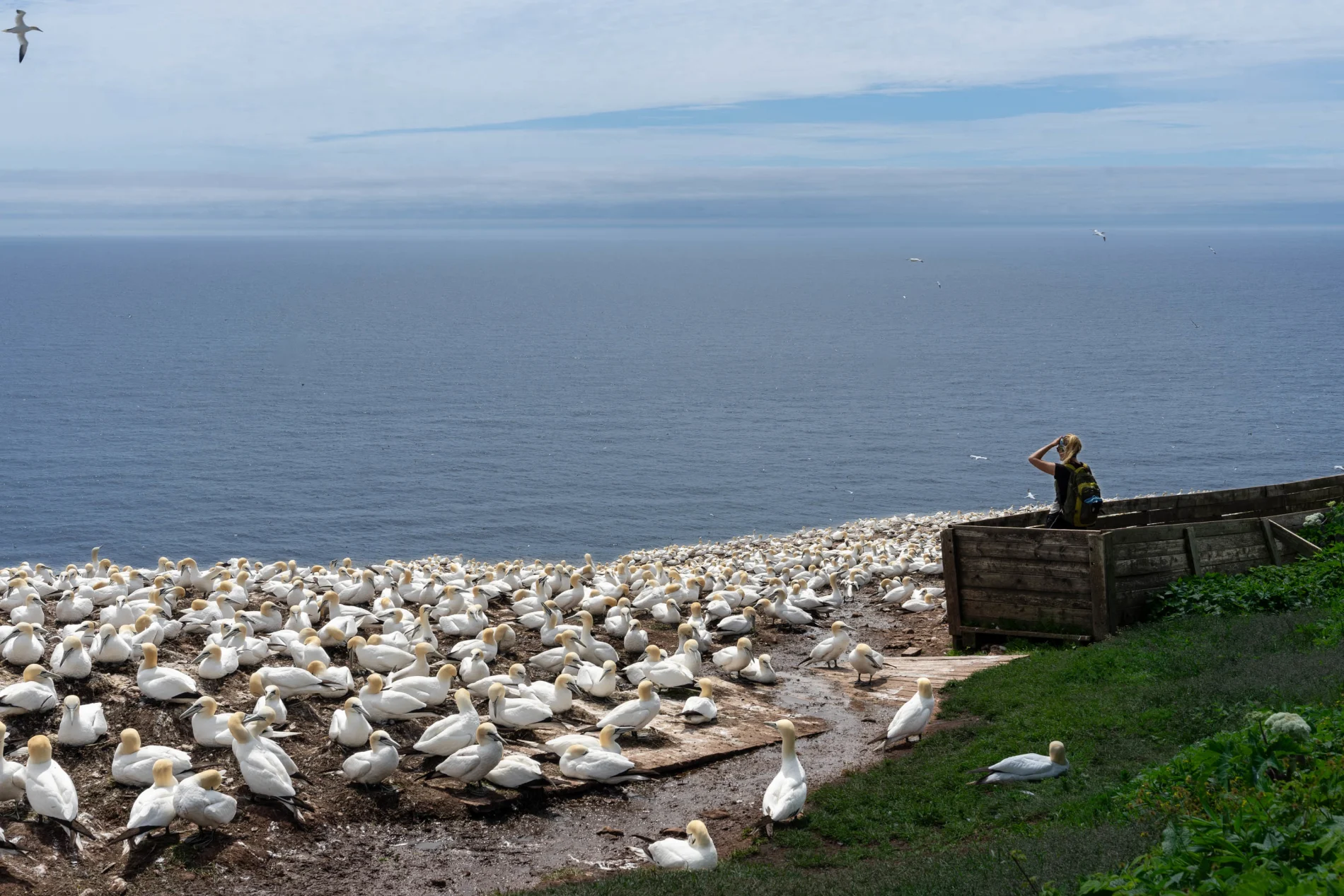
Connecting Canadians
A bird’s eye view of the oceans with northern gannets
Apr 7, 2024
(Above) Photo credit: Simon Jodoin
Eastern Quebec is home to some of the world’s best researchers on marine ecosystems. These experts have joined forces to better understand the complex interactions between species in the coastal regions of eastern Quebec in order to preserve these precious ecosystems.
High-speed connectivity enables them to share, download and analyze the vast quantities of data that are essential to their work. They’re also assisted by some very special collaborators who also benefit from this scientific research: northern gannets.
These majestic birds, found primarily along the coasts, are the ideal partners to help contribute to our understanding of marine ecosystems. Some of them are equipped with data collection devices that provide important scientific information.
Sandra Gauthier, director of the
Exploramer museum
in Sainte-Anne-des-Monts, specializing in the study and interpretation of marine biodiversity in the Saint Lawrence River and the northern Atlantic, knows something about this research. Thanks to the work of Rimouski-based researchers and the data acquired through high-speed connectivity, the northern gannet has earned a place of honour in the museum’s current exhibits, including the installation Northern Gannet: Sentinel of the Marine St. Lawrence.“It all started with Magella Guillemette and David Pelletier, researchers from the Université du Québec à Rimouski and the CÉGEP de Rimouski,” Gauthier explains. “They provided us with the scientific data, images and content. Based on that, we put together an exhibit to show people how northern gannets have become assistants in this research. By equipping the birds with GPS chips and cameras, we’re able to gain insight into their movements. When a northern gannet dives into the water, the images let us see the fish it’s hoping to catch.”

Photo credit: Simon Jodoin
Observing the oceans
Last year alone, TELUS invested $8 million in the Bas-Saint-Laurent and Gaspé Peninsula to deploy its fibre optic network and improve its 5G network coverage. These investments not only help Quebec residents to stay connected, but also turn northern gannets into ocean observers who contribute to scientific advancement.
David Pelletier, a lecturer and researcher at the CÉGEP de Rimouski, has just finished his Ph.D. work on the northern gannet. He grew up in the Bas-Saint-Laurent region and is passionate about biology and ornithology, as well as the latest technologies – especially when they can help him in his research.
“Sea birds in general are good indicators of ecosystem quality. Sailors have always used them to locate the best fishing grounds. All of that has been documented for centuries. But it’s only in the last fifteen years or so that we’ve had the idea of using them to collect samples. They’re excellent field assistants, and they’ve already got their eye on changes in fish populations.”
Pelletier adds that the northern gannet is a very accessible bird than can be seen up close in Île-Bonaventure-et-du-Rocher-Percé National Park.
“The northern gannet is one of eastern Quebec’s most iconic sea birds. When you visit the colony, you can walk right up to them, and they won’t fly away. They tolerate humans quite well. We consider them to be useful witnesses to the overall changes taking place in the Gulf of Saint Lawrence, because they’re a species that travels over long distances and doesn’t mind being handled at all. We can get hold of them in their nests, do some quick interventions, take measurements, attach the devices and release them. From a scientific perspective, it’s a great species to work with, since they’re super-predators that will readily react to any changes in the food chain.”
Some of the fishes that are part of the northern gannet’s diet are also consumed by humans. As a result, the information provided by these birds can also help us to manage our own food resources through a more detailed understanding of which species are more abundant or in decline in the river and the sea. As a strong proponent of sustainable fisheries and marine products from the Saint Lawrence, Sandra Gauthier wanted to highlight this important link between the northern gannet’s diet and our own when she and her team were developing the exhibit about these amazing sentinels.
“At first, our interest was purely from the perspective of the museum exhibit. We wanted to inform our visitors about scientific research being done by local researchers on the ecosystems of the Saint Lawrence. But then we realized that with the data that was being collected, we could also draw a parallel with another project at Exploramer – the
Fourchette Bleue
program. We established the program in 2009 to highlight certain lesser-known Saint Lawrence marine species, some of which are exported and some of which are still undervalued as potential food resources.”Launched in 2009, Fourchette Bleue showcases lesser-known marine species from the Saint Lawrence ecosystem which are more commonly exported or not yet used to their full potential as food sources. Through the use of connected monitoring devices, researchers have learned that northern gannets are consuming less and less mackerel and herring, and are increasingly switching to squid.
“That’s how we discovered that squid had returned to the Gulf of Saint Lawrence. Traditionally, squid hasn’t been an everyday food item in Quebec, but it’s now very popular in the trendier restaurants here. In the future, we might be enjoying Quebec squid at home!”
Participatory research
Exploramer’s collaboration with the researchers offers a striking new perspective on northern gannets and marine ecosystems, and also gives museum visitors the opportunity to take part in scientific research. By identifying northern gannets in millions of photos, they’re helping to train an artificial intelligence engine that will enable biologists to spot them more easily and acquire a more accurate understanding of the population.
They’re also completing the loop of connectivity alongside the northern gannets that provide the researchers with data, and the researchers themselves, who pass the data along to the museum. Encouraging the public’s involvement with the efforts of the scientific community is a powerful way of making everyone aware of their responsibilities in the fight to preserve marine life – and the northern gannet populations who are helping to monitor it.
“It’s important to share the data, to make the results and interpretations of our research accessible to a non-scientific audience – and most of all, to get people involved,” David Pelletier concludes. “We talk a lot about climate change, but the main thing is to get people actively involved in creating change. No matter what kind of science we’re talking about, we need to invite people to participate.”
This text was adapted from content created in collaboration with “Comment ça va chez vous?”, a production of the Coops de l’Information.


